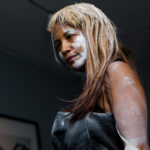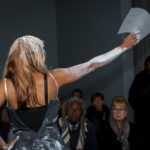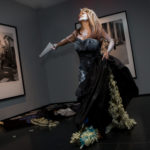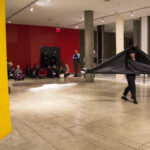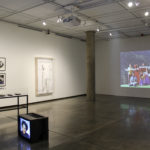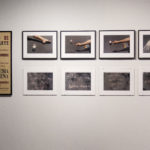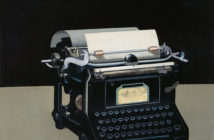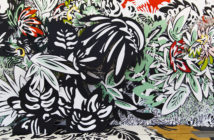For decades, Carrie Mae Weems’s staged photographs and videos have served as aids for processing the legacies of slavery, racism, and sexism in the United States. The elegant solutions in Weems’s compositions, their gravitas and narrative content, appear to operate as historical analyses, reflecting the past more than the present. If there is a call-to-action latent in Weems’s images, I was deaf to it until visiting the exhibition Carrie Mae Weems: I once knew a girl… at The Ethelbert Cooper Gallery of African and African-American Art at Harvard University. During the run of the exhibition, a performance in the gallery by the artist Dell M. Hamilton foregrounded the political-activist potential in Weems’s work.
It was the two concurrent exhibitions on Harvard’s campus, however, of artwork responding to military coups and dictatorships in Cold War Latin America that brought me to see Weems’s images as reflections on the past and provocations in the present. It is a flimsy parallel between people of color being shot dead by police officers today and the desaparecidos—dissidents, usually young men, abducted in Argentina, Chile, Colombia, El Salvador, and Guatemala, likely killed and placed in mass graves. I will return to the exhibitions of Latin American art below but first wanted to highlight a question: if the murders of dozens of thousands of people transpired in the 1960s, 70s, and 80s, and artists responded in those years, why are we only now looking at that art?
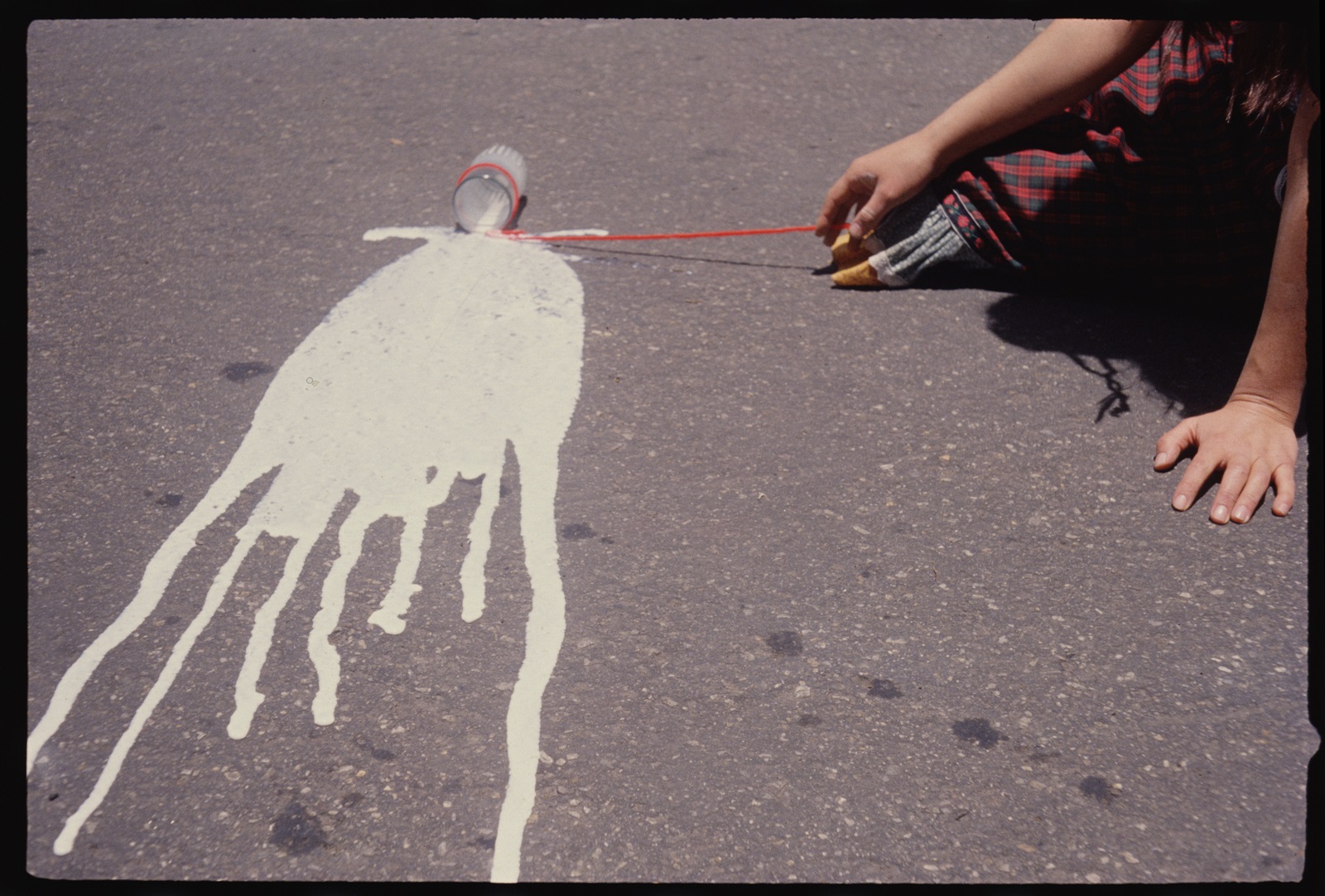
Cecilia Vicuña, Vaso de Leche, Bogotá (Glass of Milk, Bogotá), 1979. Installation of 8 photographs and a letterpress poster on paper. Variable dimensions. Private collection. Courtesy of England & Co. Gallery.
One response to this question came, indirectly, from the Cooper Gallery, suggesting today’s police brutality in the United States is part of a long history, and that we need not wait decades to acknowledge those victims or to hold their perpetrators accountable. The Latin American dictatorships were aided, if not spearheaded, by the CIA in an effort to thwart communism worldwide. Assuming that U.S. involvement in overthrowing foreign regimes is a large part of the reason the Latin American art exhibitions came to Harvard in 2016 and not sooner, we now turn back to Carrie Mae Weems with the understanding that we can learn from her images to the extent that we are ready to face our implication in them.
The main axis of the Cooper Gallery, designed by David Adjaye, is narrow and dimly lit, bringing visitors face-to-face with the art. The selection for the Weems exhibition focused on several bodies of work produced between 1997 and 2016. In the entryway, text-and-image works addressed the gender and race-based factors that structured the reception of artists such as Édouard Manet, Marcel Duchamp, Frida Kahlo, Diego Rivera, Jackson Pollock, and Weems herself. Further works documented the Du Bois Peony, which Weems named in preparation for the W.E.B. Du Bois Memorial Garden at the University of Massachusetts, Amherst. The exhibition included Afro-Chic (2009-10), a music video illustrating cultural appropriation, and The Obama Project (2016), a video that includes footage of police officers shooting unarmed black people and explores the complexity of the Obama Administration’s legacy for African Americans.

“Philadelphia Museum of Art – Philadelphia” (2006) Courtesy of the artist and Jack Shainman Gallery, New York.
The exhibition concluded with Roaming (2006) and Museum Series (2007), two sets of large-scale black and white photographs of Weems in dark dress, standing alone in front of the Philadelphia Museum of Art, the Musée du Louvre, the Jewish ghetto in ancient Rome, and other sites that historically subordinated or banished from view the female black body, among other subaltern subjects. Posing in one photograph on Mussolini’s balcony, Weems indulges in a thought experiment of how history could have happened differently if not for imperialism, colonization, fascism, and patriarchy. In the Cooper Gallery, Weems’s landscapes surrounded the viewers who, by peering into her images, doubled Weems’s pose of the lone back-facing figure (Rückenfigur) associated with German Romantic painting. Weems was not inviting me to gaze upon her, as I first thought, but placing me, the viewer, in relation to the historical episodes and locales in her photographs. The installation, on which Weems collaborated, implicated me and all other viewers as players within the history elaborated, not spectators on its outside.
The first time I saw Weems’s work in the Cooper Gallery was in the context of a live performance. At noon on Thursday, December 22, the artist Dell M. Hamilton took over the gallery to perform her piece “Blues/Blank/Black,” which uses a participatory form of drama to acknowledge black, female victims of police brutality and the resulting trauma on people of color. Over nearly half an hour, Hamilton guided her audience through the space, using refrains such as “we wore her ego as our own.” She recited the names of women such as Tarika Wilson and Sandra Bland repeatedly until the names turned into abstract sounds. She wrote the names on sheets of paper and handed them to audience members. Halfway through Hamilton changed from a white gown into a black one, putting on a light brown wig and white skin moisturizer. Handshakes and embraces over the course of the reception that followed the performance led to many of the audience unknowingly getting smeared with Hamilton’s thick white cream.
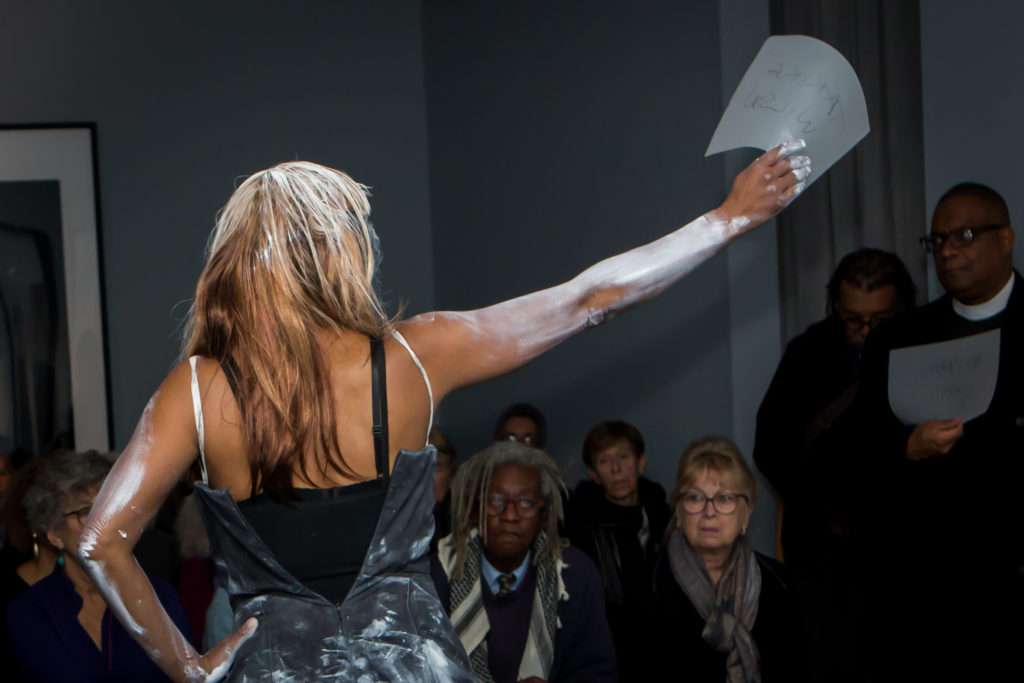
Dell M. Hamilton at her in-gallery performance in response to the Cooper Gallery’s “Carrie Mae Weems: I once knew a girl…” exhibition on December 22, 2016. Photo credit: Melissa Blackall.
As Hamilton’s performance came to a close, we were left holding the names of victims of police violence, sharing in a hushed sense of guilt, rage, and loss. We had accepted the artist’s invitation to imagine inhabiting different subjectivities and created a space to question and mourn deaths for which no one was held accountable. We were the perpetrators; we were the victims; we were their friends and family. Hamilton pointed to the difficulty of commemorating horrific acts for which no one claims responsibility. What are the vocabularies that artists use to erect memorials and monuments, to document events that have been erased from history? How can art intervene in this culture of non-accountability?
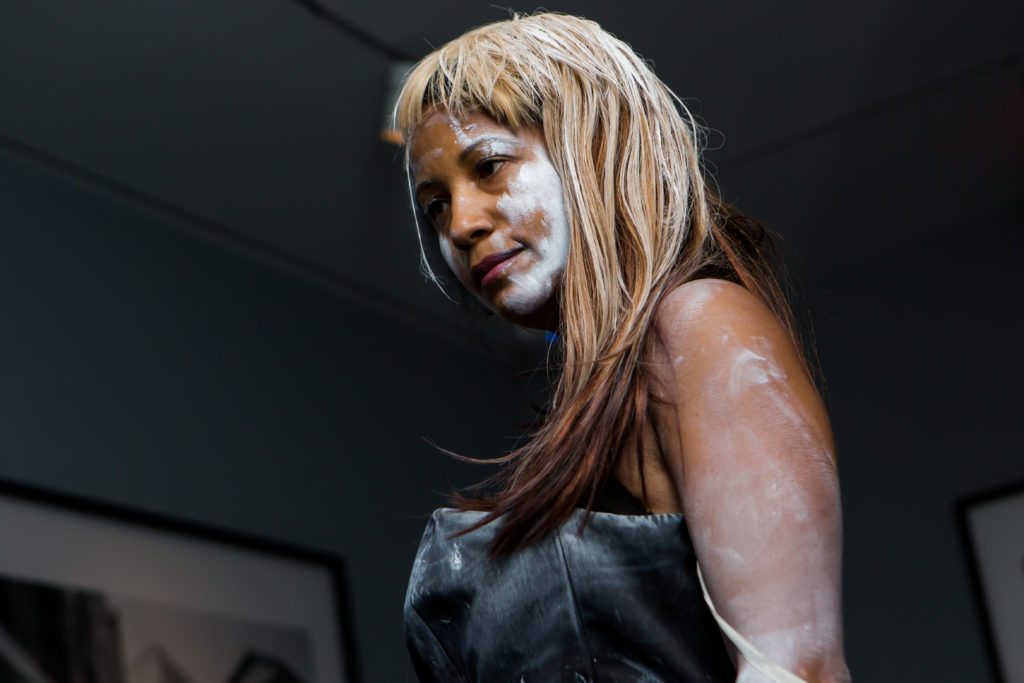
Dell M. Hamilton at her in-gallery performance in response to the Cooper Gallery’s “Carrie Mae Weems: I once knew a girl…” exhibition on December 22, 2016. Photo credit: Melissa Blackall.
Leaving Dell Hamilton’s performance, I thought about the two exhibitions of Latin American art on Harvard’s campus. At the Harvard Art Museums, the exhibition Doris Salcedo: the Materiality of Mourning includes four installations by the contemporary Colombian artist. The adjacent Carpenter Center for the Visual Arts was showing the exhibition Embodied Absence: Chilean Art of the 1970s Now. The exhibitions offer two proposals for how to memorialize those written out of history. Salcedo does it with formal elegance and the sense of fragility we get from standing before her intensely technical works. The muted, reverential installation at Harvard Art Museums evokes a sense of human absence.

Performance photography, Carmen Beuchat, Two not One II, 2016, Embodied Absence: Chilean Art of the 1970s Now, Carpenter Center for the Visual Arts, Sert Gallery, Oct 27, 2016–Jan 8, 2017. Courtesy Carpenter Center for the Visual Arts, Harvard University.
By contrast, works by Chilean artists and collectives next door at the Carpenter Center were anti-institutional, theatrical, and participatory. In addition to static art objects, the artists’ presence was manifested in live performance as well as the documentation of protests, actions, and theater pieces. Their bodies and feelings came into sharp contrast with the lifelessness of Salcedo’s works, made out of dead flower petals and inorganic materials such as metal and concrete, which gesture only abstractly to the events that inspired them. Salcedo’s art of absence complements the Carpenter Center’s art of embodiment, and a synthesis of the two visual strategies emerges as one shuttles between the buildings.
In her performance, Dell Hamilton brought together these modes of conjuring the subaltern subject at the moment of its expunction from collective memory by court acquittals and falsified news accounts. Hamilton gave new voices to Weems’s photographs, which began to look back at us as agents with a responsibility to act. Although Weems’s photographs and Hamilton’s performances are staged, both artists arrange the studio, the picture plane, and the gallery in a way that conveys a feeling of being present for something we know to be a simulation. Weems’s photographs and videos show not history, but history’s constructedness, its continual openness to a new telling with a different outcome.

Dell M. Hamilton at her in-gallery performance in response to the Cooper Gallery’s “Carrie Mae Weems: I once knew a girl…” exhibition on December 22, 2016. Photo credit: Melissa Blackall.
In their layered and meticulously narrated works, Weems and Hamilton gravitate to history’s blind spots, developing a visual language befitting the memory of those who were denied the most basic civil rights. After Hamilton’s performance, when asked what her audience was supposed to do with the name cards, she charged them with looking up the names and their stories, and to keep looking them up until we end the racist, sexist culture that continues to excuse or ignore their deaths. As an art historian, standing before images of Weems at sites of imperialistic propaganda, including art museums, I questioned how my work will contribute to the long fight for equality and justice.

“The Edge of Time - Ancient Rome” (2006) Courtesy of the artist and Jack Shainman Gallery, New York.
- “The Edge of Time – Ancient Rome” (2006) Courtesy of the artist and Jack Shainman Gallery, New York.
- Dell Hamilton at her in-gallery performance in response to the Cooper Gallery’s “Carrie Mae Weems: I once knew a girl…” exhibition on December 22, 2016. Photo credit: Melissa Blackall.
- • “Philadelphia Museum of Art – Philadelphia” (2006) Courtesy of the artist and Jack Shainman Gallery, New York.
- • “Philadelphia Museum of Art – Philadelphia” (2006) Courtesy of the artist and Jack Shainman Gallery, New York.
- Dell Hamilton at her in-gallery performance in response to the Cooper Gallery’s “Carrie Mae Weems: I once knew a girl…” exhibition on December 22, 2016. Photo credit: Melissa Blackall.
- Cecilia Vicuña, Vaso de Leche, Bogotá (Glass of Milk, Bogotá), 1979. Installation of 8 photographs and a letterpress poster on paper. Variable dimensions. Private collection. Courtesy of England & Co. Gallery.
- Performance photography, Carmen Beuchat, Two not One II, 2016, Embodied Absence: Chilean Art of the 1970s Now, Carpenter Center for the Visual Arts, Sert Gallery, Oct 27, 2016–Jan 8, 2017. Courtesy Carpenter Center for the Visual Arts, Harvard University.
- Installation view, Embodied Absence: Chilean Art of the 1970s Now, Carpenter Center for the Visual Arts, Sert Gallery, Oct 27, 2016–Jan 8, 2017. Floor: Carlos Leppe, Las Cantatrices, 1979. Left: Francisco Copello, Il Gioco dell´Ambiguita (The Ambiguity Game), 1977. Center: Catalina Parra, Imbunche gigante (Giant Imbunche), 2016. Right: Cecilia Vicuña, Sol y Dar y Dad, una palabra bailada, a danced word, 1980. Courtesy Carpenter Center for the Visual Arts, Harvard University.
- Cecilia Vicuña, Sol y Dar y Dad, una palabra bailada, a danced word (still), 1980. From the series Palabrarmas, Bogotá. Filmed in 16 mm, transferred to digital, (color, silent), 4:3, 4 min. Courtesy of the Artist.
- Installation view, Embodied Absence: Chilean Art of the 1970s Now, Carpenter Center for the Visual Arts, Sert Gallery, Oct 27, 2016–Jan 8, 2017. Cecilia Vicuña, Vaso de Leche, Bogotá (Glass of Milk, Bogotá), 1979. Courtesy Carpenter Center for the Visual Arts, Harvard University.



